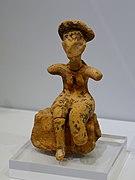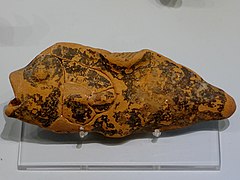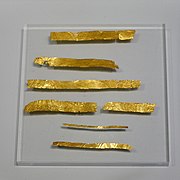Traostalos
Traostalos ( Greek Τραόσταλος ) refers to a former Minoan summit sanctuary in the municipality of Sitia in the east of the Greek island of Crete . It was discovered by Emmanuel Phygetakis and after a test excavation in 1962 by Paul Faure, it was excavated in 1963/1964 and in 1978 by Costis Davaras . A subsequent excavation took place in 1995 under Stella Chryssoulaki after illegal excavations had taken place in the meantime. The use of the sanctuary is dated to the Middle Minoan period of phases MM I to MM III, possibly beyond that to the late Minoan phase SM I (around 1800–1500 BC).
Location and description
The summit sanctuary was located on a 20 × 12 meter rectangular plateau at a height of 495 meters directly below the highest point of the mountain of the same name at 515.4 meters. The east coast of Crete on the Levantine Sea is 1.2 kilometers away from the summit of the Traostalos . The excavation site of the Minoan palace of Zakros is 3.2 kilometers south, that of Roussolakkos 7.7 kilometers in the north. Near the latter was the summit sanctuary of Petsophas , at 6.8 kilometers a little closer to Traostalos. From today's village of Azokeramos (Αζοκέραμος), the Traostalos summit sanctuary, located 1.5 kilometers to the south-east, can be reached on an unpaved road.
While the terrain breaks off on the western side of the summit, the terraced rectangular plateau is easily accessible via the gentle eastern slope. A Z-shaped Temenos wall leading north from the two-room sanctuary at the north corner protected the area from this side. The architectural structures are very poorly preserved. The plateau and the eastern slope served the deification of the votive offerings, whereas the western and southern corners of the plateau contained ashes from large fires, mixed with earth and in an oily consistency. Stella Chryssoulaki interpreted a concentration of 3–5 mm thick stone disks with a diameter of 12–15 cm as sacrificial tables.
The numerous finds were votive offerings , as they were also excavated in other summit shrines. Most were found terracotta - figurines in the form of male and female, standing or seated figures, for example a seated woman with a swollen left leg, but also various body parts that have a healing cult, and animal replicas. Among the latter there were cattle, sheep, birds (maybe pigeons), wild goats and rhinoceros beetles . Furthermore, a model ship made of clay, rod-shaped objects, miniature shoes, men statuettes and needles made of bronze, seven small gold sheet metal bands, various vessels, including found Libationsgefäße , as in the form of a fish, and inscriptions in linear a . Burned animal bones and shells lay in the layers of ash.
Overall, the time span of the classification of the finds on the Traostalos extends from the Neolithic to the post-Minoan period. The architectural remains are dated to the time of the new palace . The excavations of 1978 came to results that suggest an overlay of the material from MM I to MM III by a late Minoan SM I layer, from which the building with the two rooms could come.
- Finds from the excavation site
literature
- Paul Faure: Cultes de sommets et cultes de cavernes en Crète . In: Bulletin de Correspondance Hellénique . tape 87 , no. 2 . Ecole Française d'Athènes, 1963, ISSN 0007-4217 , p. 494–496 (French, digitized [accessed September 25, 2018]).
- Costis Davaras: A Minoan Graffito from Traostalos . In: William C. Brice (Ed.): Kadmos . tape 19 . de Gruyter, 1980, ISSN 0022-7498 , p. 87–92 (English, digitized version [accessed September 25, 2018]).
- Göran Henriksson, Mary Blomberg: Evidence for Minoan astronomical observations from the peak sanctuaries on Petsophas and Traostalos . In: Opuscula Atheniensia 21 . Gleerup, Lund 1996, pp. 99–114 (English, digitized version [PDF; 1.8 MB ; accessed on September 25, 2018]).
- Stella Chryssoulaki: The Traostalos Peak Sanctuary: Aspects of Spatial Organization . In: Robert Laffineur, Robin Hägg (Ed.): Potnia, Deities and Religion in the Aegean Bronze Age, Proceedings of the 8th International Aegean Conference Göteborg, Göteborg University, April 12-15, 2000 (= Aegaeum. Annales d'archéologie égéenne de l'Université de Liège et UT-PASP . no. 22 ). Universite de Liege, University of Texas, Lüttich, Austin 2001, p. 57–66 (English, archive.org [PDF; accessed September 25, 2018]).
- Peter E. Blomberg: A new interpretation of the figurines from Petsophas and Traostalos . In: Pepragmena 9. Diethnous Krētologikou Synedriou, Elounta, 1-6 Oktōvriou 2001 . Eteria Kritikon Istorikon Meleton, Iraklio 2006, p. 333–347 (English, digital version [PDF; 7.4 MB ; accessed on September 25, 2018]).
- Christine Morris, Alan Peatfield: Health and Healing on Cretan Bronze Age Peak Sanctuaries . In: Demetrios Michaelides (Ed.): Medicine and Healing in the Ancient Mediterranean World . Oxbow, Oxford 2014, ISBN 978-1-78297-235-8 , pp. 54–63 (English, excerpt [accessed September 25, 2018]).
- Krzysztof Nowicki: Final Neolithic Crete and the Southeast Aegean . de Gruyter, Boston, Berlin 2014, ISBN 978-1-61451-031-4 , 15 Traostalos, p. 94 (English, online [accessed January 30, 2019]).
- Gernot Heinrich: Minoan height sanctuaries . In: Melissa Vetters (ed.): The Minoan Crete (Crete excursion May 01, 2017– May 12, 2017, part 1) . University of Salzburg, Salzburg 2017, Traostalos, p. 76 ( digitized version [PDF; 7.6 MB ; accessed on September 25, 2018]).
Individual evidence
- ↑ Monika Zacher: Possible Minoan Crete Proto-Palatial Communications Infrastructure of Palaces and Peak Sanctuaries with Gavdos and Malaxa. Peak Sanctuaries (Elevation - Meters), No. 42.minoer.net, February 3, 2012, accessed September 25, 2018 .
- ↑ Stella Chryssoulaki: The Traostalos Peak Sanctuary: Aspects of Spatial Organization . In: Robert Laffineur, Robin Hägg (Ed.): Potnia, Deities and Religion in the Aegean Bronze Age, Proceedings of the 8th International Aegean Conference Göteborg, Göteborg University, April 12-15, 2000 (= Aegaeum. Annales d'archéologie égéenne de l'Université de Liège et UT-PASP . no. 22 ). Universite de Liege, University of Texas, Lüttich, Austin 2001, p. 57, 60 (English, archive.org [PDF; accessed September 25, 2018]).
- ↑ a b Constanze Aichner: Sanctuaries and shrines in palaces and settlements of the old palace period of Crete. A comparison of the ritual inventory . University of Vienna, Vienna 2013, Traostalos, Lasithiou, p. 50 ( online [PDF; 13.7 MB ; accessed on September 25, 2018]).
- ↑ Costis Davaras: On the origin of the Phaistos disc . In: Ernst Grumach (Ed.): Kadmos . tape 6 . de Gruyter, 1967, ISSN 0022-7498 , p. 102 ( digitized version [accessed September 25, 2018]).
- ↑ Angeliki Pilali-Papasteriou: The bronze animal figures from Crete (= prehistoric bronze finds . Division I, volume 3 ). Beck, Munich 1985, ISBN 978-3-406-30241-1 , animal statuettes as votive offerings: Bergheiligtümer, p. 150–151 ( excerpt [accessed September 25, 2018]).
- ↑ Constanze Aichner: Sanctuaries and shrines in palaces and settlements of the old palace period of Crete. A comparison of the ritual inventory . University of Vienna, Vienna 2013, Traostalos, Lasithiou, p. 51–52 ( online [PDF; 13.7 MB ; accessed on September 25, 2018]).
- ↑ Elissa Z. Faro: Ritual Activity and Regional Dynamics: Towards a Reinterpretation of Minoan Extra-Urban Ritual Space . Dissertation. University of Michigan, Ann Arbor 2008, Appendix II: Catalog of Peak Sanctuaries, p. 277 (English).
Web links
- Traostalos - MRS. In: Digital Crete: Archaeological Atlas of Crete. Foundation for Research and Technology-Hellas (FORTH), Institute for Mediterranean Studies(English).
- Alexandros Roniotis: Traostalos. CretanBeaches, accessed September 25, 2018 .
- Found objects. users.uoi.gr, December 19, 2014, accessed September 25, 2018 (Greek, PDF, 1009.2 KB).
Coordinates: 35 ° 7 ′ 35.4 ″ N , 26 ° 16 ′ 2.2 ″ E








